Mathematics Assignment Paper: Geometry and Algebra Solutions
VerifiedAdded on 2023/04/24
|6
|774
|414
Homework Assignment
AI Summary
This mathematics assignment paper presents solutions to various geometry and algebra problems. It includes calculating the circumference of a cylinder, applying Pythagoras' theorem, determining volumes, and finding surface areas. The assignment also addresses congruence and similarity in tria...
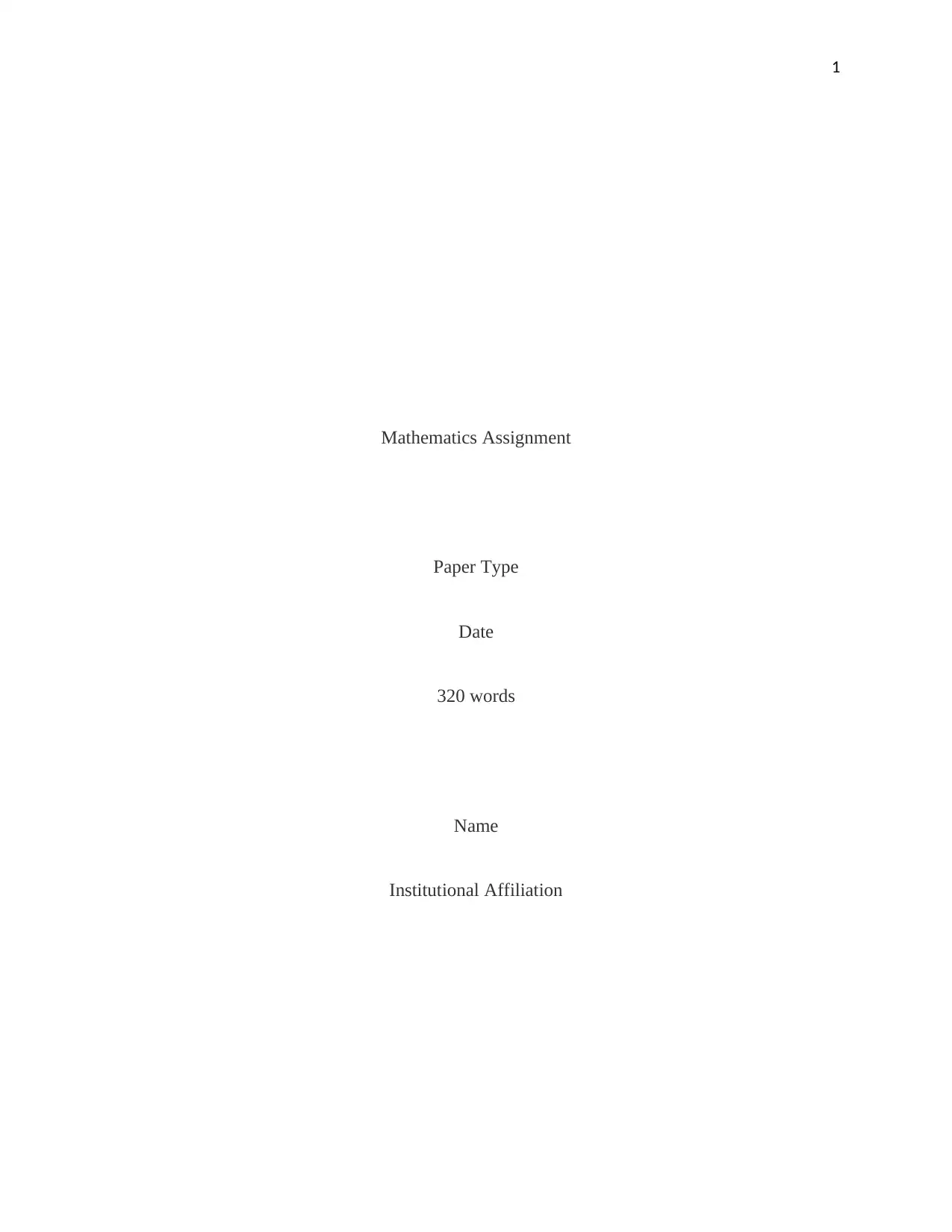
1
Mathematics Assignment
Paper Type
Date
320 words
Name
Institutional Affiliation
Mathematics Assignment
Paper Type
Date
320 words
Name
Institutional Affiliation
Paraphrase This Document
Need a fresh take? Get an instant paraphrase of this document with our AI Paraphraser
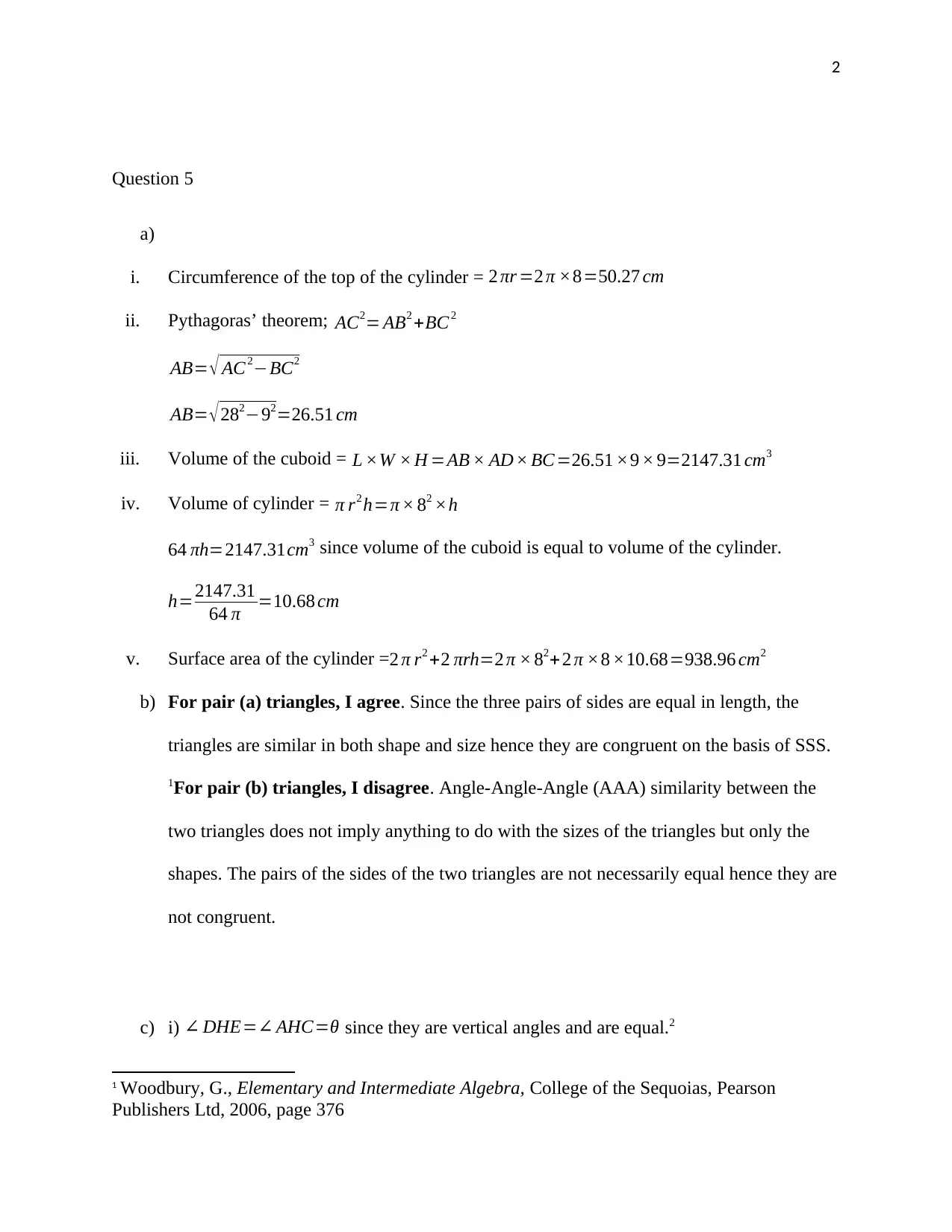
2
Question 5
a)
i. Circumference of the top of the cylinder = 2 πr =2 π ×8=50.27 cm
ii. Pythagoras’ theorem; AC2= AB2 +BC2
AB= √ AC 2−BC2
AB= √ 282−92=26.51 cm
iii. Volume of the cuboid = L ×W × H =AB × AD × BC =26.51 ×9 × 9=2147.31 cm3
iv. Volume of cylinder = π r2 h=π × 82 ×h
64 πh=2147.31cm3 since volume of the cuboid is equal to volume of the cylinder.
h=2147.31
64 π =10.68 cm
v. Surface area of the cylinder =2 π r2 +2 πrh=2 π × 82+2 π ×8 ×10.68=938.96 cm2
b) For pair (a) triangles, I agree. Since the three pairs of sides are equal in length, the
triangles are similar in both shape and size hence they are congruent on the basis of SSS.
1For pair (b) triangles, I disagree. Angle-Angle-Angle (AAA) similarity between the
two triangles does not imply anything to do with the sizes of the triangles but only the
shapes. The pairs of the sides of the two triangles are not necessarily equal hence they are
not congruent.
c) i) ∠ DHE=∠ AHC=θ since they are vertical angles and are equal.2
1 Woodbury, G., Elementary and Intermediate Algebra, College of the Sequoias, Pearson
Publishers Ltd, 2006, page 376
Question 5
a)
i. Circumference of the top of the cylinder = 2 πr =2 π ×8=50.27 cm
ii. Pythagoras’ theorem; AC2= AB2 +BC2
AB= √ AC 2−BC2
AB= √ 282−92=26.51 cm
iii. Volume of the cuboid = L ×W × H =AB × AD × BC =26.51 ×9 × 9=2147.31 cm3
iv. Volume of cylinder = π r2 h=π × 82 ×h
64 πh=2147.31cm3 since volume of the cuboid is equal to volume of the cylinder.
h=2147.31
64 π =10.68 cm
v. Surface area of the cylinder =2 π r2 +2 πrh=2 π × 82+2 π ×8 ×10.68=938.96 cm2
b) For pair (a) triangles, I agree. Since the three pairs of sides are equal in length, the
triangles are similar in both shape and size hence they are congruent on the basis of SSS.
1For pair (b) triangles, I disagree. Angle-Angle-Angle (AAA) similarity between the
two triangles does not imply anything to do with the sizes of the triangles but only the
shapes. The pairs of the sides of the two triangles are not necessarily equal hence they are
not congruent.
c) i) ∠ DHE=∠ AHC=θ since they are vertical angles and are equal.2
1 Woodbury, G., Elementary and Intermediate Algebra, College of the Sequoias, Pearson
Publishers Ltd, 2006, page 376

3
∠ BCF=∠ AHC=θsince they are corresponding angles and are equal.
Considering triangle ACH, ∠ HAC +∠ ACH +∠ AHC =180°
Therefore, θ=∠ AHC =180°−∠ HAC−∠ ACH =180 °−87 ° −38 °=55 °
θ=55°
ii) Since EF is a straight line, ∠ ACH +∠ ACB+∠ BCF=180 °
∠ ACB=180° −55° −38 °=87 °
Alternatively, ∠HAC =∠ ACB=87 ° since they are alternate interior angles and are equal
Question 6.
a) i) a=3
d=4
L=39
number of terms , n= L−a
d +1=39−3
4 +1=10
ii) 1Sum = n
2 [2 a+ ( n−1 ) d ]
10
2 [ 2 ×3+ ( 10−1 ) 4 ]=210
∑ ¿210
b) i) ( 3 x−11 ) ( 7 x +3 )=21 x2 +9 x−77 x−33=21 x2−68 x−33
2 Burzynski, D. and Ellis, W., Fundamentals of Mathematics, Rice University Press, 1989, page
547
∠ BCF=∠ AHC=θsince they are corresponding angles and are equal.
Considering triangle ACH, ∠ HAC +∠ ACH +∠ AHC =180°
Therefore, θ=∠ AHC =180°−∠ HAC−∠ ACH =180 °−87 ° −38 °=55 °
θ=55°
ii) Since EF is a straight line, ∠ ACH +∠ ACB+∠ BCF=180 °
∠ ACB=180° −55° −38 °=87 °
Alternatively, ∠HAC =∠ ACB=87 ° since they are alternate interior angles and are equal
Question 6.
a) i) a=3
d=4
L=39
number of terms , n= L−a
d +1=39−3
4 +1=10
ii) 1Sum = n
2 [2 a+ ( n−1 ) d ]
10
2 [ 2 ×3+ ( 10−1 ) 4 ]=210
∑ ¿210
b) i) ( 3 x−11 ) ( 7 x +3 )=21 x2 +9 x−77 x−33=21 x2−68 x−33
2 Burzynski, D. and Ellis, W., Fundamentals of Mathematics, Rice University Press, 1989, page
547
⊘ This is a preview!⊘
Do you want full access?
Subscribe today to unlock all pages.

Trusted by 1+ million students worldwide
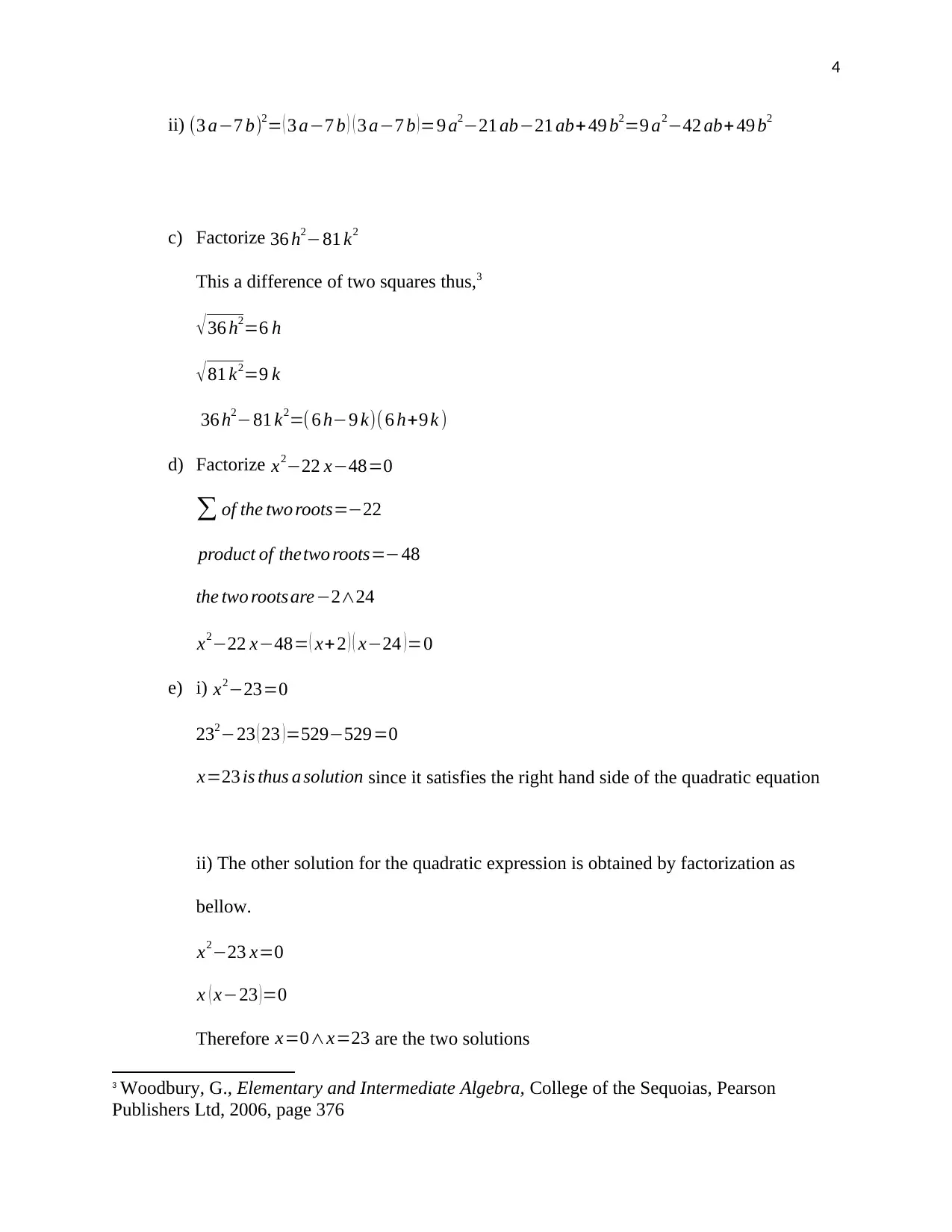
4
ii) (3 a−7 b)2= ( 3 a−7 b ) ( 3 a−7 b )=9 a2−21 ab−21 ab+ 49 b2=9 a2−42 ab+ 49 b2
c) Factorize 36 h2−81 k2
This a difference of two squares thus,3
√36 h2=6 h
√ 81 k2=9 k
36 h2−81 k2=( 6 h−9 k)( 6 h+9 k )
d) Factorize x2−22 x−48=0
∑ of the two roots=−22
product of thetwo roots=−48
the two roots are−2∧24
x2−22 x−48= ( x+ 2 ) ( x−24 )=0
e) i) x2−23=0
232−23 ( 23 )=529−529=0
x=23 is thus a solution since it satisfies the right hand side of the quadratic equation
ii) The other solution for the quadratic expression is obtained by factorization as
bellow.
x2−23 x=0
x ( x−23 )=0
Therefore x=0∧x=23 are the two solutions
3 Woodbury, G., Elementary and Intermediate Algebra, College of the Sequoias, Pearson
Publishers Ltd, 2006, page 376
ii) (3 a−7 b)2= ( 3 a−7 b ) ( 3 a−7 b )=9 a2−21 ab−21 ab+ 49 b2=9 a2−42 ab+ 49 b2
c) Factorize 36 h2−81 k2
This a difference of two squares thus,3
√36 h2=6 h
√ 81 k2=9 k
36 h2−81 k2=( 6 h−9 k)( 6 h+9 k )
d) Factorize x2−22 x−48=0
∑ of the two roots=−22
product of thetwo roots=−48
the two roots are−2∧24
x2−22 x−48= ( x+ 2 ) ( x−24 )=0
e) i) x2−23=0
232−23 ( 23 )=529−529=0
x=23 is thus a solution since it satisfies the right hand side of the quadratic equation
ii) The other solution for the quadratic expression is obtained by factorization as
bellow.
x2−23 x=0
x ( x−23 )=0
Therefore x=0∧x=23 are the two solutions
3 Woodbury, G., Elementary and Intermediate Algebra, College of the Sequoias, Pearson
Publishers Ltd, 2006, page 376
Paraphrase This Document
Need a fresh take? Get an instant paraphrase of this document with our AI Paraphraser
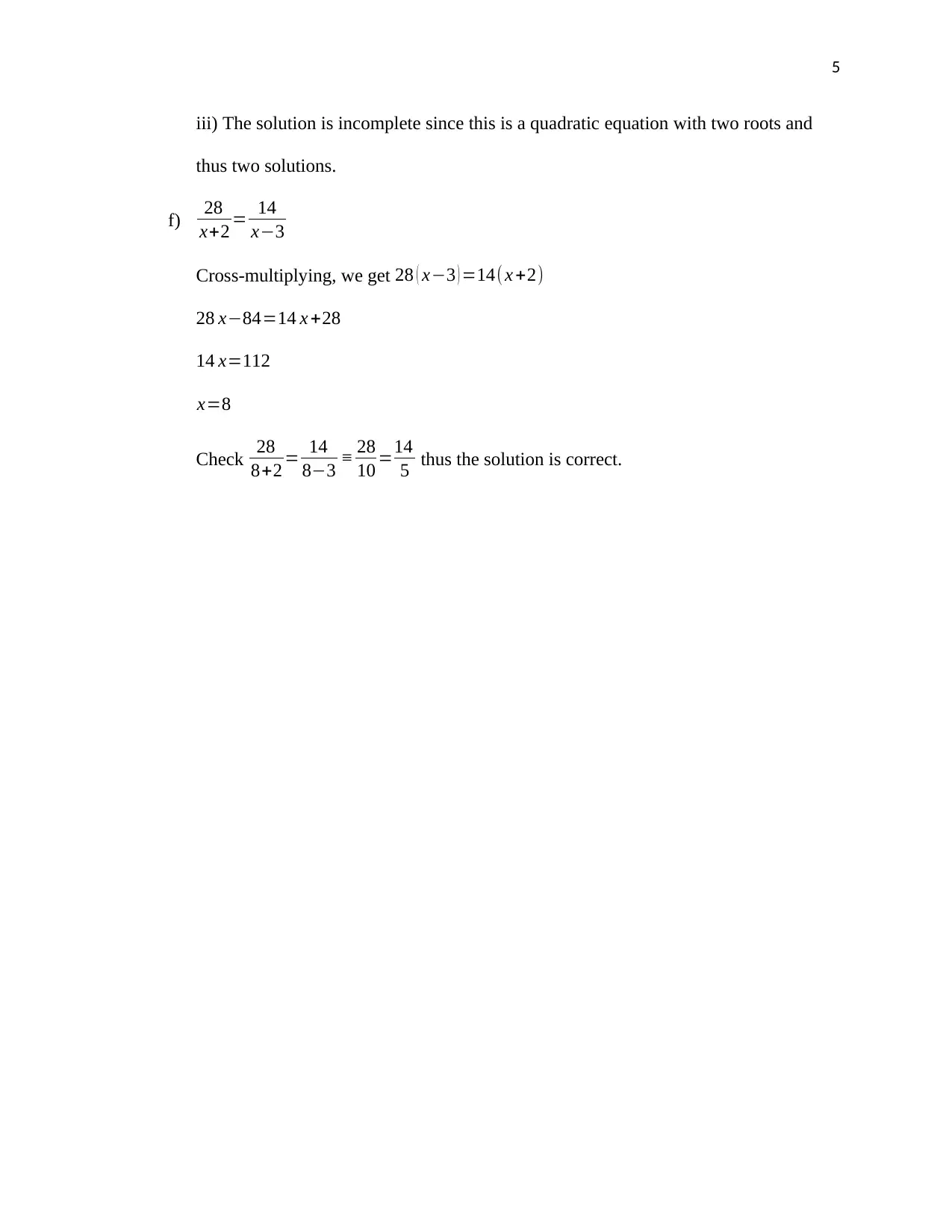
5
iii) The solution is incomplete since this is a quadratic equation with two roots and
thus two solutions.
f) 28
x+2 = 14
x−3
Cross-multiplying, we get 28 ( x−3 ) =14(x +2)
28 x−84=14 x +28
14 x=112
x=8
Check 28
8+2 = 14
8−3 ≡ 28
10 =14
5 thus the solution is correct.
iii) The solution is incomplete since this is a quadratic equation with two roots and
thus two solutions.
f) 28
x+2 = 14
x−3
Cross-multiplying, we get 28 ( x−3 ) =14(x +2)
28 x−84=14 x +28
14 x=112
x=8
Check 28
8+2 = 14
8−3 ≡ 28
10 =14
5 thus the solution is correct.
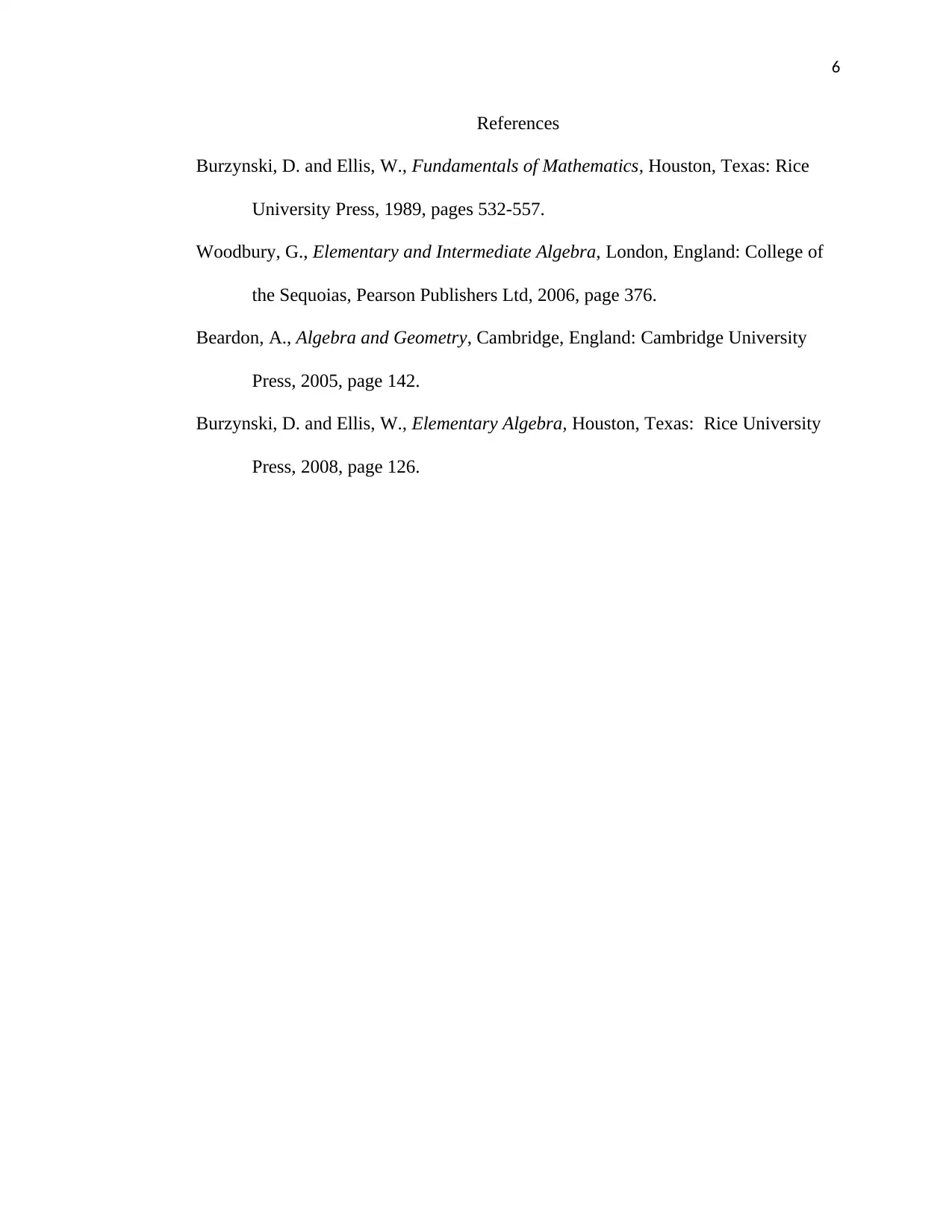
6
References
Burzynski, D. and Ellis, W., Fundamentals of Mathematics, Houston, Texas: Rice
University Press, 1989, pages 532-557.
Woodbury, G., Elementary and Intermediate Algebra, London, England: College of
the Sequoias, Pearson Publishers Ltd, 2006, page 376.
Beardon, A., Algebra and Geometry, Cambridge, England: Cambridge University
Press, 2005, page 142.
Burzynski, D. and Ellis, W., Elementary Algebra, Houston, Texas: Rice University
Press, 2008, page 126.
References
Burzynski, D. and Ellis, W., Fundamentals of Mathematics, Houston, Texas: Rice
University Press, 1989, pages 532-557.
Woodbury, G., Elementary and Intermediate Algebra, London, England: College of
the Sequoias, Pearson Publishers Ltd, 2006, page 376.
Beardon, A., Algebra and Geometry, Cambridge, England: Cambridge University
Press, 2005, page 142.
Burzynski, D. and Ellis, W., Elementary Algebra, Houston, Texas: Rice University
Press, 2008, page 126.
⊘ This is a preview!⊘
Do you want full access?
Subscribe today to unlock all pages.

Trusted by 1+ million students worldwide
1 out of 6
Your All-in-One AI-Powered Toolkit for Academic Success.
+13062052269
info@desklib.com
Available 24*7 on WhatsApp / Email
![[object Object]](/_next/static/media/star-bottom.7253800d.svg)
Unlock your academic potential
© 2024 | Zucol Services PVT LTD | All rights reserved.

